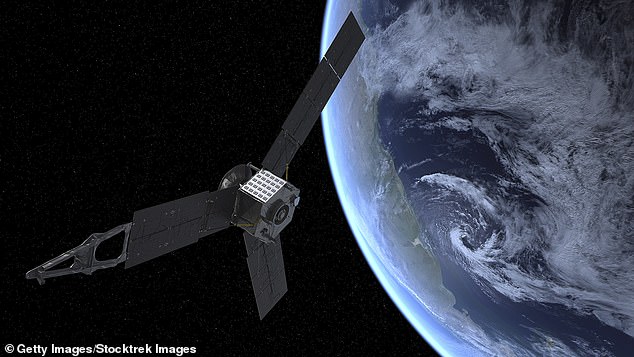Ride on a flight to Jupiter! NASA’s Juno spacecraft flies just 2,000 miles above the tops of the giant gas cloud in a stunning clip
- New NASA clip shows Juno’s 41st flyby of Jupiter, which took place on April 9
- At its closest, Juno was just over 2,050 miles above Jupiter’s cloud tops
- Juno launched from Cape Canaveral, Florida, in 2011 to study Jupiter from orbit
NASA has released a new clip of its Juno spacecraft scraping Jupiter’s clouds as it flies back to the planet.
The new footage, taken by Juno on April 9 during its 41st flyby of Jupiter, shows what it would be like to ride with the spacecraft.
At its closest, Juno was just over 2,050 miles (3,300 km) above Jupiter’s colorful cloud tops.
At that moment, it was traveling about 131,000 miles per hour (210,000 kilometers per hour) relative to the planet, according to NASA.
Artist’s impression of NASA’s solar-powered Juno spacecraft with Earth in the background
“Scientist Andrea Lack created this animated sequence using raw JunoCam image data,” NASA said in a statement.
These initial images are publicly available at NASA Juno mission web page.
The space agency also said that during its April 9 flyby, Juno was more than 10 times closer to Jupiter than the satellites in geosynchronous orbit.
It was traveling five times faster than the Apollo missions in the 1960s and 1970s when it left Earth for the moon.
Juno is a solar-powered spacecraft that spans the width of a basketball court and makes long, moving orbits around Jupiter.
It has three giant blades that extend about 20 meters from its six-sided cylindrical body.
Juno launched from Cape Canaveral, Florida, more than a decade ago – on August 5, 2011 – to study Jupiter from its orbit.
The spacecraft successfully entered Jovian orbit on July 5, 2016, after completing its five-year journey.

Initial images of the Jupiter flyby in April are publicly available on NASA’s Juno mission webpage
Juno will continue to investigate the largest planet in the solar system until September 2025, or until the end of the spacecraft’s life.
In June 2021, Juno made a close flyby of Ganymede, the largest moon of Jupiter and the largest moon in our solar system.
It passed 645 miles (1,038 kilometers) from the icy moon, which also has its own magnetic field.
The sound picked up by the space probe revealed a strange series of beeps and pulses at different frequencies coming from the Jovian moon.
Stunning images were also captured by JunoCam’s photographer aboard Juno as it flew over Ganymede at nearly 12 miles per second.
Ads

“Extreme travel lover. Bacon fanatic. Troublemaker. Introvert. Passionate music fanatic.”








More Stories
A review of Rhengling at Erfurt Theater
MrBeast Sued Over 'Unsafe Environment' on Upcoming Amazon Reality Show | US TV
A fossilized creature may explain a puzzling drawing on a rock wall.